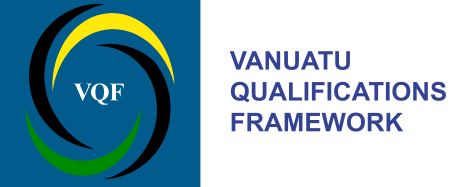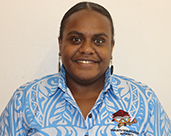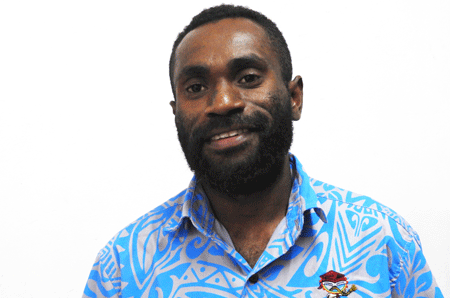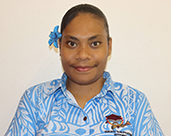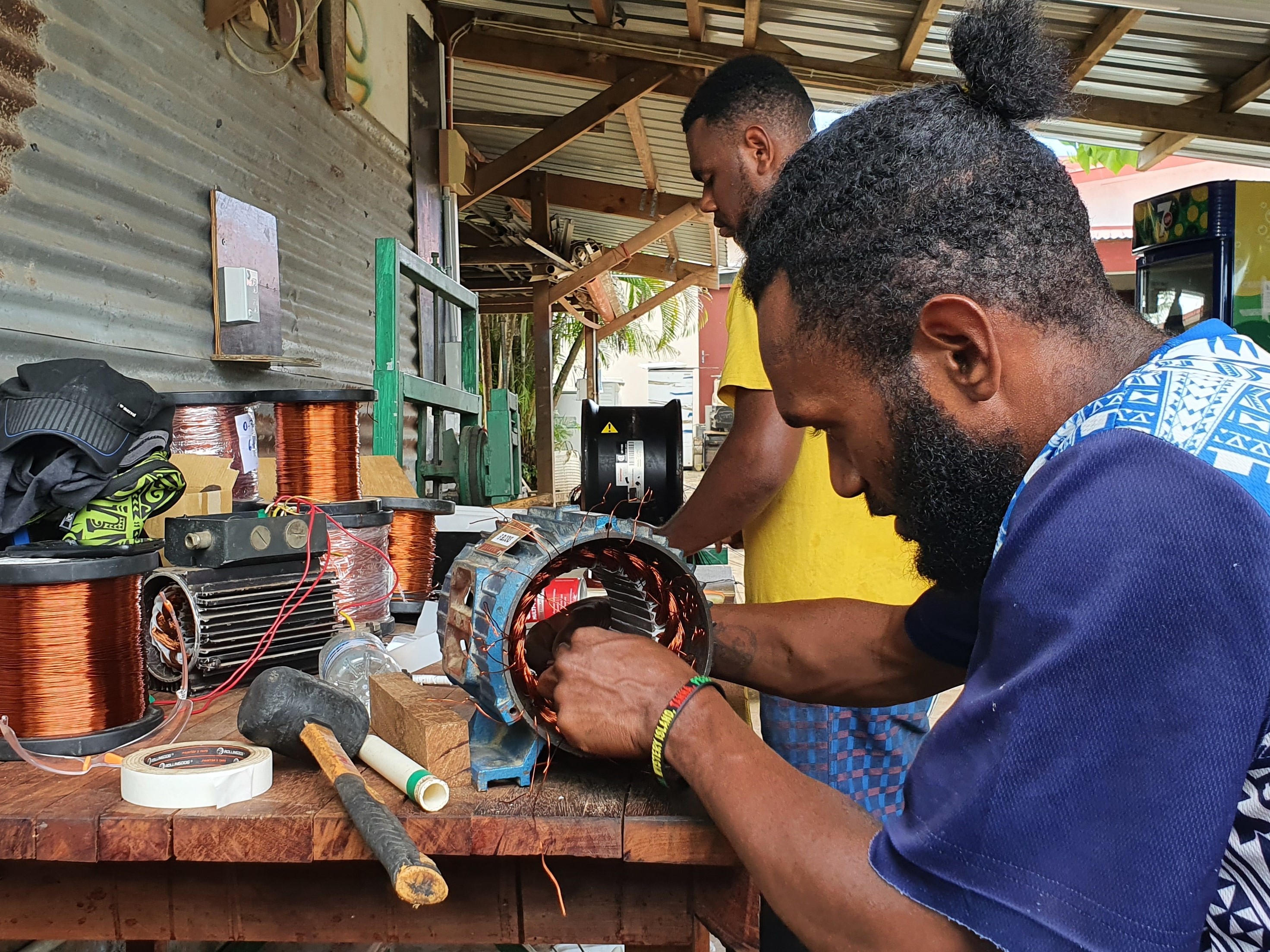|
Accreditation standards
|
Reference points used to decide whether a proposed course meets the desired level of quality in order to be named an Accredited Course.
|
|
Accredited course
|
A course that has been accredited by the VQA
|
|
Accrediting agency
|
Agency that manages course accreditation under national legislation, e.g. national qualifications agency, official review board or other nationally approved body or agency with the remit to accredit courses or qualifications. All accrediting agencies are subject to ongoing monitoring and periodic review of their performance against standards.
|
|
Achievement-Based Assessment
|
The process of collecting evidence and making judgements whether learning outcomes have been achieved. A marking schedule shows the relation between the criteria being assessed and the work produced by the learner, to receive a specific mark. Individual marks for all assessment tasks are combined into a grade for the component.
|
|
Appeal
|
A formal request from an individual/organisation requesting a change in or confirmation of a decision if the individual/organisation believes it was denied a fair decision.
|
|
Applicant
|
Provider applying with the VQA for registration, course accreditation, approval to deliver, or associated approvals.
|
|
Approval to Deliver
|
Formal approval given to a Registered Provider to deliver an accredited course
|
|
Assessment
|
The process of collecting and evaluating evidence to establish the level of an individual's performance.
|
|
Assessment Task
|
A specific discrete activity designed to obtain evidence about a learner's achievement of the published learning outcomes of a component. Examples are: practical on the job work, essays, presentations, performance, exhibition or final examination.
|
|
Assessment standards
|
Criteria or a framework of criteria against which the competencies, knowledge, skills, and/or attitudes of learners are measured.
|
|
Associated Qualification
|
Qualification that is associated with a particular course, that is, the qualification to which the particular course leads. Each course has only one associated qualification.
|
|
Audit Team
|
Group of people appointed by the VQA to carry out an audit activity.
|
|
Authority
|
The executive branch of the Vanuatu Qualifications Authority
|
|
Award of a Qualification
|
The formal acknowledgement that a graduate has met the requirements of the qualification and is eligible for certification through a qualification document.
|
|
Benchmarking
|
The process of comparing a proposed course with similar courses in the Pacific region, and demonstrating comparability with these courses. Benchmarking is a mandatory part of the Course Accreditation process.
|
|
Block credit
|
Block credit may be granted on the basis of studies judged to be comparable to a specified part of a given course. Block credit, sometimes referred to as 'articulation credit', is often granted where formal agreements exist.
|
|
Board or VQA Board
|
The governance branch of the Vanuatu Qualifications Authority
|
|
CEO
|
The Chief Executive Officer of the VQA
|
|
Certification
|
The verification and authentication of an individual's entitlement to a qualification.
|
|
Certification Documentation
|
The set of official documents that confirms that a qualification has been completed and awarded. This documentation includes a qualification document and a record of achievement and may include a Vanuatu Graduation Statement.
|
|
Clustering
|
Clustering is the process of grouping related units of competency so that the units can be taught, learned and assessed together.
Clustering can be meaningful in the context of a particular industry or learning environment. Clustering may enable learners to practise the job tasks that are reflected in the units of competency in a wider context as they would in an actual workplace, which helps with transferring the specific knowledge and skills to the actual workplace. It may also enable the teachers to draw on broader real workplace functions when developing learning activities. Clustering may also assist with making the teaching and learning process more efficient as it can reduce the amount of time spent on assessment and moderation.
|
|
Combined Qualification
|
Two or more qualifications that are awarded when a graduate has completed the requirements for two or more different qualifications at consecutive VQF levels. A separate qualification document is issued for each qualification completed.
|
|
Competency
|
The quality of being competent: possession of required skills, knowledge, qualification or capacity in work/study.
|
|
Competency-Based Assessment
|
The process of collecting evidence and making judgements on whether competency has been achieved. The purpose of the assessment is to confirm that an individual can perform to the standards expected in the workplace as expressed in the relevant competency standards.
|
|
Completion of a Qualification
|
Sign that a learner has met the requirements of a qualification, prior to award of the qualification.
|
|
Component of a course
|
The smallest part of a course that can be separately assessed and for which credits can be awarded. The total of components makes up the course. Components are often also referred to as units, modules, papers, subjects.
|
|
Component Code
|
Unique code identifying a component or a unit of competency.
|
|
Component Descriptor
|
A brief description of a component including the learning outcomes, content and assessment which is used as the basis for the development of the teaching, learning and assessment activities in the component.
|
|
Continuous Improvement
|
The ongoing effort of a Registered PSET Provider to improve its outcomes, practices, compliance, and internal monitoring and self-review processes.
|
|
Course
|
Structured sequence of education and training designed to meet the requirements of a qualification
|
|
Course Accreditation
|
The process of assessment and official approval of a qualification plus the course that meets the requirements of this qualification, usually for a particular period of time, as being able to meet particular requirements defined by the VQA. Once courses have been accredited they are included in the Register of Accredited Courses, which is maintained by the VQA.
|
|
Course Accreditation Standards
|
See Accreditation Standards
|
|
Course Development Steering Committee
|
Committee supporting the development of a course to provide advice on education and training needs and technical expertise in the field of the course, to coordinate with other relevant stakeholders of the course, and to formally endorse the proposed course on behalf of the relevant industry sector or community.
|
|
Credit
|
The agreed measure of the estimate amount of learning typically required by an average learner to gain a qualification. This estimate of learning time includes time spent on lectures, time spent on practical work, time spent on self-study and research, time spent on preparing and doing assignments and time spent in assessment. In the VQF, one credit equals 10 notional hours of learning.
Credit is awarded when achievement is assessed and meets specified standards. Evidence of achievements can be collected from a variety of sources.
|
|
Credit Accumulation
|
Credit accumulation is the process of collecting credit for learning towards a qualification.
|
|
Credit Transfer
|
The award of credit for a component based on evidence of prior achievement of equivalent learning outcomes through accredited or recognized formal learning.
|
|
Criterion
|
A specific measure against which a judgement is made.
|
|
Delivery
|
The combined teaching, learning and assessment activities, and context, resources, and staff in a course, in accordance with the specifications of the course as laid out in its Course Accreditation Document.
|
|
Diagnostic assessment
|
The process of collecting and evaluating evidence to establish the level of an individual's performance, for the purpose of finding out what the learners already know and are able to do, to inform teaching and learning.
|
|
Double Qualification
|
Two qualifications that are awarded when the requirements of two VQF qualifications of the same type have been completed, concurrently and in less time than the minimum time required to complete each qualification separately. A separate qualification document is issued for each of the two qualifications completed. Double qualifications may be issued by one provider or by two providers under a formal agreement. Other terms in use for double qualification arrangements include cotutelle, dual or multi-badged.
|
|
Entry Requirements
|
The knowledge, skills and attitudes a learner must possess in order to be admitted to a course. Entry requirements are appropriate if all learners meeting them will normally complete the course successfully, and learners not meeting them would only have a very small chance of completing the course successfully.
|
|
Exit qualification
|
A qualification awarded to learners who withdraw early from the course in which they initially enrolled, but who have completed the requirements that define the exit qualification.
An exit qualification must have its own graduate profile and completion requirements, and meet specified community and/or industry needs.
The details of exit qualifications are specified in and approved through the Course Accreditation document of the course of which they are an exit.
|
|
Formative assessment
|
The process of collecting and evaluating evidence to establish the level of an individual's performance, for the purpose of providing feedback to the learner and the teacher on how well the learner is progressing, to inform teaching and learning.
|
|
Functional Analysis
|
A technique used to identify the labour competencies inherent in a productive function. Such function may be defined at the level of an occupational sector, an enterprise, a group of enterprises or a whole sector of production or services.
|
|
Graduate
|
A person who has met all requirements of a VQF qualification and been awarded this VQF qualification. A person who has been awarded a statement of attainment has not met all requirements of a VQF qualification and is therefore not a graduate.
|
|
Graduate Profile
|
The expression of the set of knowledge, skills and the application of the knowledge and skills a person has acquired and is able to demonstrate as a result of learning upon successful completion of an entire course.
|
|
Guidelines
|
include quality standards, standards, instructions, specifications, procedures, requirements and criteria;
|
|
Industry Skills Council
|
Council whose members are the key industry contacts for the VQA. The Council provides independent industry advice on the training and skill needs of industry which will facilitate workforce development.
The advice provided by the Industry Skills Council (ISC) assists the VQA to identify training priorities, formulate policy, implement reforms, design industry-related strategies and partner on industry skill initiatives.
|
|
Internal Monitoring
|
Quality monitoring conducted by a Registered Provider to monitor and review its own performance against the registration standards.
|
|
Issuance Number
|
The unique number assigned to qualification documentation to enable verification of authenticity.
|
|
Joint Qualification
|
A qualification awarded to a graduate who has completed a single qualification at more than one provider under a formal agreement between the providers. One qualification document is issued to the graduate.
|
|
Learner
|
A person who is enrolled in a course offered by a Registered Provider
|
|
Learning Outcome
|
The expression of the set of knowledge, skills and attitudes a person has acquired and is able to demonstrate as a result of learning.
Learning outcomes can be defined for an entire course (see Graduate Profile), for a component and for an individual classroom session or learning activity.
|
|
Level
|
Number indicating the depth and complexity of the outcomes of a qualification or component. The VQF consists of 10 levels, with level 1 representing the least depth and complexity and level 10 the most. All qualifications on the VQF are assigned one of the 10 levels.
|
|
Major
|
A group of course components that focuses on specialization in a particular subfield of study in a degree course. A major comprises at least 40% of the credits in a course and particularly includes components at the highest levels in the course.
Completing a major can be recognized through a qualifier in the qualification title.
|
|
Marking Schedule
|
A scoring tool that explicitly represents the performance expectations for an assessment task.
|
|
Mode of delivery
|
The principal way in which a course is being taught. Modes of delivery include face-to-face, on-the job or work-based, distance by correspondence, online, and blended (combination of face-to-face and online)
|
|
Moderation (of Assessment)
|
A quality review and assurance process which supports assessment design and marking activities. It involves confirmation that summative assessment is valid, fair, transparent, current, sufficient, reliable, flexible, and feasible.
|
|
Moderator
|
Appropriately qualified academic staff member who is responsible for ensuring the quality setting and marking of learners' assessments.
|
|
Monitoring
|
A form of Quality Audit including the evaluation of a subset of a Registered Provider's processes and outcomes over a short period of time.
|
|
National Qualification
|
National qualifications recognise competencies, skills, knowledge and/or attitudes that meet a nationally endorsed graduate profile and include nationally endorsed units of competency. Courses can only be registered with associated national qualifications if they are entirely structured using VQA approved units of competency.
Courses with associated national qualifications are developed by registered providers with support from VQA.
National qualifications and the courses leading to these qualifications are owned by VQA.
|
|
Pathway of courses
|
A series of courses, each leading to a separate qualification, following each other to assist a flexible and staged approach to learners' capacity development and achievement of the ultimately desired qualification
|
|
Post-Assessment Moderation
|
Moderation of the assessment process and designated marked learner work to ensure that all marking is consistent and in line with assessment principles and the published assessment criteria.
|
|
Post-School Education and Training
|
Education and training activities that occur outside of formal primary and secondary education and include universities, colleges of higher learning, technical training institutes, community colleges, nursing schools, and other similar organisations
|
|
Post-nominals
|
The abbreviated forms of a VQF qualification type and field.
|
|
Pre-assessment Moderation
|
A quality control process that validates if the assessment tasks and materials meet the assessment principles before they are used for assessment.
|
|
Provider
|
An organisation that is offering, or intends to offer, post-school education and training in Vanuatu.
|
|
Provider Qualification
|
Provider qualifications recognise the knowledge and skills that meet the qualification's graduate profile statements as identified by an individual provider in collaboration with its stakeholders. Courses with associated provider qualifications consist of a coherent structure of provider-developed components which collectively lead to the graduate profile.
A provider qualification is developed by a provider and is owned by the provider who first developed and gained accreditation for the qualification.
The title of a provider qualification includes the name of the provider or organisation that developed and owns the qualification.
|
|
PSET
|
Post-School Education and Training
|
|
Record of Achievement
|
A record of the grades for all components leading to a VQF qualification in which a learner has been enrolled at an institution. The record of achievement is issued with the qualification at the graduation.
|
|
Qualification
|
Certificate, diploma or degree awarded by a provider, having affirmed that a person has achieved the stated learning outcomes or competencies at the determined standard
|
|
Qualification Code
|
The unique code assigned by an accrediting authority to a qualification to enable verification of authenticity.
|
|
Qualification Document
|
The official document that confirms that a qualification has been awarded. A qualification document can be a 'certificate', 'diploma' and/or a 'degree'.
|
|
Qualifier
|
Addition between brackets to the title of a qualification to indicate that the graduate specialised in a particular subfield as part of achieving the qualification.
|
|
Quality Assurance Committee
|
Committee of the VQA Board with responsibility for assessing provider registration and course accreditation applications
|
|
Quality Assurance Officers
|
VQA officers with responsibility for assuring the quality of PSET providers and their courses.
|
|
Quality
|
Fit for purpose. Quality is best defined in the context in which it is applied. Quality can mean any of the following: excellence, meeting standards or thresholds and benchmarks, customer satisfaction.
|
|
Quality Audit
|
The process of systematic examination by an internal or external quality auditor or audit team of an organisation's outcomes, processes and/or systems to evaluate whether the organisation conforms to set requirements and operates effectively.
|
|
Quality Management System
|
A set of policies and procedures to direct the practices in the core business areas of an organisation.
|
|
Quality Monitoring
|
The evaluation of a subset of the Registered Provider's processes and outcomes over a short period of time.
|
|
Quality Review
|
The evaluation of all of the Registered Provider's processes and outcomes over an extended period of time.
|
|
Recognition of Prior Learning (RPL)
|
The generic term for formal assessment of a learner's current knowledge and skills to confirm and recognise the learning outcomes a learner has already obtained in non-formal, informal, experiential, workplace and/or formal learning contexts.
|
|
Record of Achievement
|
A record of the grades for all components leading to a VQF qualification in which a learner has been enrolled at a provider. The record of achievement is issued with the qualification at the graduation.
|
|
Registration Code
|
The unique code assigned by VQA to a Registered Provider to enable verification of authenticity.
|
|
Registered Provider
|
PSET Provider who is currently registered with the VQA
|
|
Registration standards
|
For a particular profession (for example Nursing): reference points used by a professional standard-setting body to decide whether a person has the competencies to become a registered professional (for example a Registered Nurse).
For a PSET provider: reference points used to decide whether a PSET provider has demonstrated the quality required to be given the title Registered Provider or Accredited Course
|
|
Renewal of Course Accreditation or Re-Accreditation
|
When a course is accredited, an expiry date for the accreditation is set. Before the expiry date a re-accreditation of the course is required, for the course to remain on the Register of Accredited Courses.
Re-accreditation involves in-depth review and revision of the course, followed by a process of application, evaluation and official approval of the course and the qualification to which the course leads against the VQA criteria for accreditation.
|
|
Renewal of Registration
|
With approval of its registration, a provider receives notification of the registration expiry date. Before the expiry date a renewal of registration is required, for the provider to remain registered with the VQA.
|
|
Research
|
Research is an intellectually controlled investigation which leads to advances in knowledge through the discovery and codification of new information or the development of further understanding about existing information, and practice. It is a creative, cumulative and independent activity conducted by people with knowledge of the theories, methods and information of the principal field of inquiry and its cognate areas(s). Research typically involves either investigation of an experimental or critical nature, or artistic endeavour of the type exemplified by musical composition. The results of research must be open to scrutiny and formal evaluation by others in the field of inquiry and this may be achieved through publication in peer-reviewed books and serials, or through public presentation.
|
|
Review
|
A form of Quality Audit which entails an in-depth evaluation of all of a Registered Provider's processes and outcomes over an extended period of time.
|
|
Risk management
|
The ongoing effort of a Registered PSET Provider to manage any risks to its operations, to prevent harm to learners and other stakeholders and to ensure that its processes keep running smoothly.
|
|
Specialisation
|
A group of components within a course that focuses on a particular subfield of study in a sub-degree course. A specialisation comprises at least 40% of the credits in a course. A specialisation can be recognised through a qualifier in the qualification title.
|
|
Specified Credit
|
Specified credit is credit granted towards particular or specific components in a course.
|
|
Stakeholder
|
A person, group of people, or organization, including learners, with an interest or investment in a provider or a course and who is impacted by and cares about its operations and outcomes.
|
|
Standard
|
A reference point or norm against which other things can be evaluated. It expresses a broader principle or objective.
|
|
Standards-based assessment
|
Assessment of learners against pre-defined standards or learning outcomes.
There are two types of standards-based assessment currently in use in Vanuatu: competency-based assessment and achievement-based assessment.
|
|
Statement of Attainment
|
A certification that confirms that an accredited course is partially completed.
|
|
Summative assessment
|
The process of collecting and evaluating evidence to establish the level of an individual's performance, for the purpose of proving this level to learners and other relevant stakeholders. Summative assessments are marked or graded and formally reported.
|
|
Training Package
|
A document describing a range of nationally approved units of competency, as well as guidelines how these units can be packaged into a vocational course at a particular level, which meets the VQF requirements for courses and qualifications.
VQA has training packages available for a wide range of industries.
|
|
Unit of Competency
|
A unit of competency is an approved specification of a job task, in terms of its required knowledge, skills and attitudes, to a standard that is expected in the workplace. A unit of competency is a special case of a component.
|
|
Unspecified Credit
|
Credit granted for prior learning when an exact or near exact course equivalence cannot be demonstrated.
|
|
Validation
|
The process of gathering and analysing feedback from key stakeholders and using this feedback to improve the proposed design of a course. Validation is a mandatory part of the Course Accreditation process.
|
|
Validation Committee
|
Committee within the VQA with responsibility for checking the sufficiency, validity, reliability, authenticity and currency of registration and accreditation application documentation
|
|
Vanuatu Graduation Statement
|
Supplementary statement to certification documentation that provides information to enhance understanding of the qualification by learners, employers, industry, professional associations and internationally. A Vanuatu graduation statement is issued only on award of a qualification.
|
|
VQA or Authority
|
The executive branch of the Vanuatu Qualifications Authority
|
|
VQAF
|
Vanuatu Quality Assurance Framework, which comprises the national standards for Provider Registration, Course Accreditation, Quality Assurance of Assessment, and for the Vanuatu Qualifications Authority.
|
|
VQF
|
Vanuatu Qualifications Framework
|
|
VQF Qualification
|
A certificate, diploma or degree awarded by a Registered Provider, having affirmed that the person receiving the award has achieved the stated learning outcomes or competencies at the standards prescribed for the qualification.
|
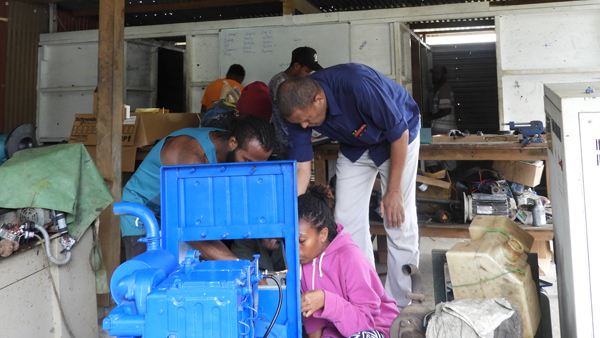
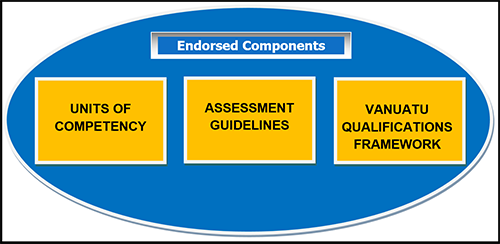

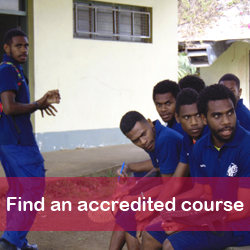

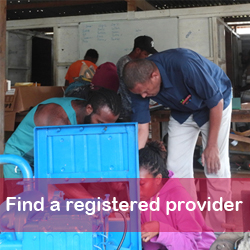
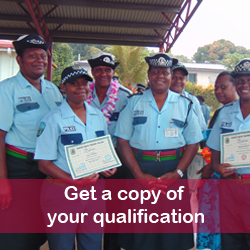
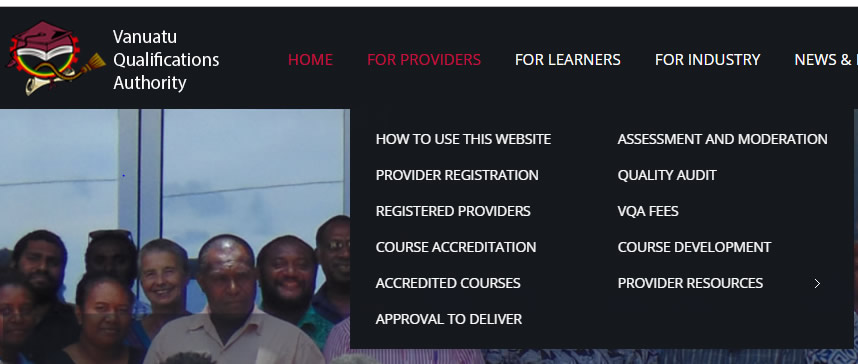
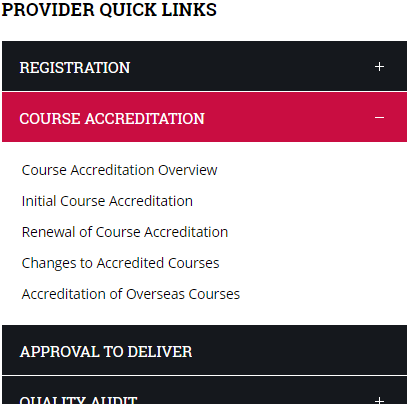 When you are on one of these pages, most of the time we will show you a menu on the side as well, with "Quick Links". You can use these to quickly jump to other information you are looking for. If the item has a little "+" behind it, there are more links hidden underneath. Click the menu item to reveal them.
When you are on one of these pages, most of the time we will show you a menu on the side as well, with "Quick Links". You can use these to quickly jump to other information you are looking for. If the item has a little "+" behind it, there are more links hidden underneath. Click the menu item to reveal them.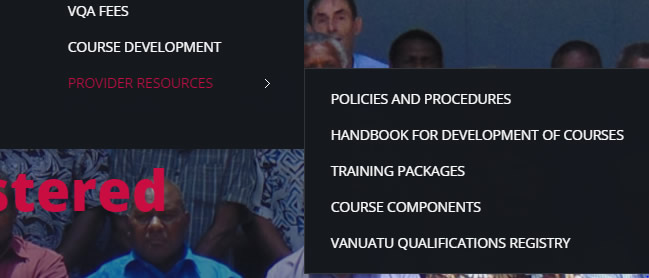
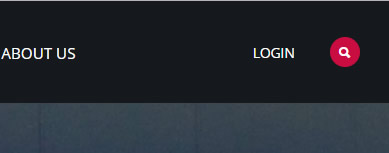


 When you are on one of these pages, most of the time we will show you a menu on the side as well, with "Quick Links". You can use these to quickly jump to other information you are looking for. If the item has a litte "+" behind it, there are more links hidden underneath. Click the menu item to reveal them.
When you are on one of these pages, most of the time we will show you a menu on the side as well, with "Quick Links". You can use these to quickly jump to other information you are looking for. If the item has a litte "+" behind it, there are more links hidden underneath. Click the menu item to reveal them.
